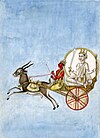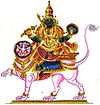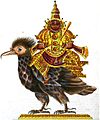Navagraha
This article has multiple issues. Please help improve it or discuss these issues on the talk page. (Learn how and when to remove these messages)
|

Graha (Sanskrit gráha "seizing, laying hold of, holding",[1] Tamil: kōḷ) are astrological figures in Hindu astrology. There are nine, the Navagraha (Tamily kōṇmīṉ, "imperial stars"), which includes the planets Mars, Mercury, Jupiter, Venus, and Saturn; the Sun; the Moon; and positions in the sky, Rahu (north or ascending lunar node) and Ketu (south or descending lunar node).
The Navagraha
Surya

Sūrya (Tamil: Ñāyiṟu) is the chief, the solar deity, one of the Ādityas, son of Kaśyapa and one of his wives Aditi, of Indra, or of Dyaus Pita. He has hair and arms of gold. His chariot is pulled by seven horses, which represent the seven chakras. He presides as "Ravi" over "Ravi-vaara" or Sunday.
In Hindu religious literature, Surya is notably mentioned as the visible form of God that one can see every day. Furthermore, Shaivites and Vaishnavas often regard Surya as an aspect of Shiva and Vishnu, respectively. For example, the sun is called Surya Narayana by Vaishnavas. In Shaiva theology, Surya is said to be one of the Astamurti. He is said to be of the sattva guna and represents the soul, the king, highly placed persons or fathers. According to Hindu scriptures, among the more renowned progenies of Surya are Shani, Yama and Karna. Invoking the Gayatri Mantra or the Adityahridayam are known to please Surya. The grain associated with the Sun is whole wheat and the number associated to the Surya is 1.
Chandra

Candra (Tamil: Tiṅkaḷ) is a lunar deity. Chandra is also known as Soma. He is described as young, beautiful, fair; two-armed and having in his hands a club and a lotus.[2] He rides his chariot - the moon - across the sky every night, pulled by ten white horses or an antelope. He is connected with dew, and as such, is one of the gods of fertility. He is also called Nishadipati and Kshuparaka ("one who illuminates the night").[3] He as Soma, presides over Somavaaram or Monday. He has sattva guna and represents the mind, the Queen or Mother.
Mangala

Mangala (Devanagari: मंगल, Kannada: ಮಂಗಳ, Telugu : మంగళ, Tamil: செவ்வாய், cevvāi) is Bhauma ('son of Bhumi' or Bha) in Sanskrit.[4] He is the god of war and is celibate. He is considered the son of Prithvi or Bhumi, the Earth Goddess. He is the owner of the Aries and Scorpio signs, and a teacher of the occult sciences (Ruchaka Mahapurusha Yoga). He is of Tamas Guna in nature and represents Energetic action, confidence and ego. He is painted red or flame colour, four-armed, carrying a trident, club, lotus and a spear. His Vahana (mount) is a ram. He presides over 'Mangala-vaara' or Tuesday.[10] There is a famous pilgrim place Mangalanatha (in Ujjain, Madhya Pradesh, India). People who suffer from troubles related to Mangala Graha in their horoscope visit there on Tuesday. By worshiping & satisfying Mangal Graha, devotees get blessings & mercy of Mangala Devata. Only two temples of Mangala devata in India, of which one is in Amalner(Maharashtra) and another in Vaitheeswaran Kovil, Tamil Nadu.
Budha

Budha (Devanagari: बुध, Kannada: ಬುಧ, Telugu:బుదా, Tamil: புதன், putan) is the god of the planet Mercury and the son of Chandra (the moon) with Tara (Taraka). He is also the god of merchandise and protector of merchants. He is of Rajas Guna and represents Communication.
He is represented as being mild, eloquent and of greenish colour. He is represented holding a scimitar, a club and a shield, riding a winged lion in Ramghur temple. In other illustrations, he holds a sceptre and lotus and rides a carpet or an eagle or a chariot drawn by lions.[5]
Budha presides over 'Budha-vaaram' or Wednesday. In modern Telugu Hindi, Bengali, Marathi, Kannada and Gujarati, Wednesday is called Budhavaara; in Tamil and Malayalam it is Budhan.
Guru

Brihaspati (Devanagari: बृहस्पति, Kannada: ಗುರು, Telugu : గురు, Tamil: வியாழன், viyāzhan) is the Guru of Devas, personification of piety and religion, the chief offerer of prayers and sacrifices, represented as the Purohita of the gods with whom he intercedes for men. He is the Lord of planet Jupiter. He is of Sattva Guna and represents knowledge and teaching. He is often known simply as "Guru".
According to Hindu scriptures, he is the guru of the Devas and the nemesis of Shukracharya, the guru of the Danavasa. He is also known Guru, the god of wisdom and eloquence, to whom various works are ascribed, such as the "atheistic" Barhaspatya sutras. Guru is usually depicted with an elephant or chariot drawn by eight horses as his vehicle. He is also depicted in a lotus flower.
His Tattva or element is Akasha or ether, and his direction is north-east. He is described of yellow or golden colour and holding a stick, a lotus and his beads. He presides over 'Guru-vaaram', Brihaspativaara or Thursday.[5]
Shukra

Shukra, Kannada: ಶುಕ್ರ, Telugu:శుక్ర, Tamil: வெள்ளி, veḷḷi the Sanskrit for "clear, pure" or "brightness, clearness", is the name the son of Bhrigu and Ushana, and preceptor of the Daityas, and the guru of the Asuras, identified with the planet Venus (with honorific, शुक्राचार्य Shukracharya). He presides over 'Shukra-vaara' or Friday. He is Rajas in nature and represents wealth, pleasure and reproduction.
He is of white complexion, middle-aged and of agreeable countenance. He is described variously mounted, on a camel or a horse or a crocodile. He holds a stick, beads and a lotus and sometimes a bow and arrow.[6]
In Astrology, there is a dasha or planetary period known as Shukra Dasha which remains active in a person's horoscope for 20 years. This dasha is believed to give more wealth, fortune and luxury to one's living if a person has Shukra positioned well in his horoscope as well as Shukra being an important benefic planet in his/her horoscope.
Shani

Shani (Devanagari: शनि, Śani, Kannada: ಶನಿ, Telugu : శని,Tamil: சனி, cani) is one of the nine primary celestial beings in Hindu astrology (that is, Vedic astrology). Shani is embodied in the planet Saturn. Shani is the son of Surya. His Tattva or element is air, and his direction is west. He is Tamas in nature and represents learning the hard way, Career and Longevity.
The origin of word Shani(शनि) comes from the following: Shanaye Kramati Sa: (शनये क्रमति सः) i.e. the one who moves slowly. Shani is actually a demi-god and is a son of Surya (the Hindu Sun God) and surya's wife Chhaya. It is said that when he opened his eyes as a baby for the very first time, the sun went into an eclipse, which clearly denotes the impact of Shani on astrological charts (horoscope).
He is depicted dark in colour, clothed in black; holding a sword, arrows and two daggers and variously mounted on a black crow or a raven. He presides over 'Shani-var' or Saturday.[6]
Rahu

Rahu (Devanagari: राहु, Kannada: ರಾಹು, Telugu :రాహువు,Tamil: ராகு, rāku) is God of the Ascending / North lunar node. Rahu is the head of the demonic snake that swallows the sun or the moon causing eclipses, according to Hindu scriptures. He is depicted in art as a dragon with no body riding a chariot drawn by eight black horses. He is a Tamas Asura who does his best to plunge any area of one's life he controls into chaos. The rahu kala is considered inauspicious.
According to legend, during the Samudra manthan, the asura Rahu drank some of the divine nectar. But before the nectar could pass his throat, Mohini (the female avatar of Vishnu) cut off his head. The head, however, remained immortal and is called Rahu, while the rest of the body became Ketu. It is believed that this immortal head occasionally swallows the sun or the moon, causing eclipses. Then, the sun or moon passes through the opening at the neck, ending the eclipse.
Ketu

Ketu (Devanagari: केतु, Kannada: ಕೇತು, Telugu :కెతువు, Tamil: கேது, kētu) is the Lord of Descending. He is considered as Tail of the Demon Snake. It is believed to have a tremendous impact on human lives and also the whole creation. In some special circumstances it helps someone achieve the zenith of fame. He is Tamas in nature and represents supernatural influences.
Associated characters
Each of the graha has associations with various characters, such as colors, metals, etc. The following table gives the most important associations:
| Character | Surya Deva (sun) | Chandra (Moon) | Mangala (Mars) | Budha (Mercury) |
|---|---|---|---|---|
| Consort | Saranyu & Chhaya | Rohini | Shaktidevi | Ila |
| Color | Gold | Silver | Red | Green |
| Gender Associated | Male | Male | Male | Male |
| Element | Fire | Water | Fire | Earth |
| God | Agni | Varuna | Murugan | Vishnu |
| Pratyadi Devataa | Rudra | Gowri | Murugan | Vishnu |
| Metal | Gold | Silver | Copper | Zinc |
| Gemstone | Ruby | Pearl/Moonstone | Red Coral | Emerald |
| Body Part | Bone | Blood | Marrow | Skin |
| Taste | Pungent | Salt | astringent | salt |
| Food | Wheat | Rice | Pigeon pea | Mung bean |
| Season | Summer | Winter | Summer | Autumn |
| Direction | East | North West | South | North |
| Day | Sunday | Monday | Tuesday | Wednesday |
| Tone (Svara) | Ga | Ma | Re | Sa |
| Character | Guru (Jupiter) | Shukra (Venus) | Shani (Saturn) | Rahu (north node) | Ketu (south node) |
|---|---|---|---|---|---|
| Consort | Tara | Sukirthi & Urjaswathi | Neeladevi(Jestadevi) | Simhi | Chitralekha |
| Color | Yellow | White | Black/Blue | Dark Blue | Smoky Grey |
| Gender Associated | Male | Female | Neutral | Male | Neutral |
| Element | Ether | Water | Air | Air | Earth |
| God | Indra | Indrani | Brahma | Nirriti | Ganesha |
| Pratyadi Devataa | Brahma | Indra | Yama | Durga | Chitragupta |
| Metal | Gold | Silver | Iron | Lead | Mercury |
| Gemstone | Yellow Sapphire | Diamond | Blue Sapphire | Hessonite | Cat's Eye |
| Body Part | Brain | Semen | Muscles | Head | Skin |
| Taste | Sweet | Sour | sweet | - | - |
| Food | Chickpea | kidney beans | Sesame | Urad (bean) | Horse gram |
| Season | Winter | Spring | All Seasons | - | - |
| Direction | North East | South East | West | South West | - |
| Day | Thursday | Friday | Saturday | Saturday | -Tuesday |
| Tone (Svara) | Dha | Ni | Pa | - | - |
Positioning in Hindu custom
As per Hindu customs, the Navagraha are typically placed in a single square with the Sun (Surya) in the center and the other deities surrounding Surya; no two of them are positioned to face each other. In South India, their images are generally found in all important Saiva temples. They are invariably placed in a separate hall, on a pedestal of about three feet in height, usually to the north-east of the sanctum sanctorum.
There are 2 kinds of installation of the planets when arranged in this fashion, known as Agama Prathishta and Vaidika Prathishta.
In Agama Prathishta, Surya occupies the central place, Chandra on Surya's east, Budha on his south, Brihaspati on his west, Shukra on his north, Mangala on his south-east, Shani on his south-west, Rahu on north-west and Ketu in the north-east. Temples such as Suryanar temple, Tiruvidadaimarudur, Tiruvaiyaru and Tirucchirappalli follow this system.

 Rahu |
 Shukra |
 Ketu |
 Brihaspati |
 Surya |
 Chandra |
 Shani |
 Budha |
 Mangal |
In Vaidika Pradishta, Surya is still in the centre, but Shukra is in the east, Mangala in the south, Shani in the west, Brihaspati in the north, Chandra in the south-east, Rahu in the south-west, Ketu in the north-west and Budha in the north-east.
 Ketu |
 Brihaspati |
 Budha |
 Shani |
 Surya |
 Shukra |
 Rahu |
 Mangal |
 Chandra |
Other temples install the Navagrahas in other arrangements.
In Ramanathapuram district, in a place called Navapashana, nine stone slabs are worshipped as the Navagraha. In temples like Tirukuvalai and Tiruvarur, the nine planets stand in a straight line. In Thirupanjali temple, they are represented by nine holes in a stone.
The Gangaikonda Cholapuram temple boasts a unique structure wherein the nine grahas are installed in a single stone. Surya is prominently displayed in this structure with seven horses in a chariot with two wheels and a charioteer. The other eight grahas are placed in eight directions with the sun in the centre.
At Agasthiyar Temple Chennai Pondy Bazaar a totally different form of position is done with Sun at the elevated centre and the remaining planets in an octagonal structure. This is called Agasthiyar Kattu (the form promoted by Sage Agasthiya (Agastya).
Navagraha temples

In Indian Astrology movement of the Navagrahas is considered to have a major role in influencing the fortunes of any individual. In order to mitigate the negative effects of a planet which is debilated in the birth chart or to provide more potency to a planet that is in an exalted state, believers undertake pilgrimage to designated Navagraha temples.
Navagraha worship
Traditional Hindu astrologers castes in India are known to be major experts of Navagraha, many people would approach a Hindu astrologer when they have problems and ask them on how to overcome them by performing certain rituals which involve worship of Navagraha to overcome ill effects. People of the Kaniyar (Ganaka) caste of south India, particularly in Kerala state and the Graha Bipra, Acharya or Ganak Brahmins in the north eastern states of India have custom of high preference for worshiping planets and sun. They are believed to be the descendants of Sakaldwipiya Brahmins, who were once sun worshipers by nature.
See also
Notes
- ^ Sanskrit-English Dictionary by Monier-Williams, (c) 1899
- ^ Mythology of the Hindus By Charles Coleman p.131
- ^ Mythology of the Hindus By Charles Coleman p.132
- ^ Gopal, Madan (1990). K.S. Gautam (ed.). India through the ages. Publication Division, Ministry of Information and Broadcasting, Government of India. p. 75.
- ^ a b Mythology of the Hindus By Charles Coleman p.133
- ^ a b Mythology of the Hindus By Charles Coleman p.134

